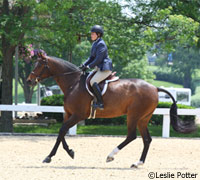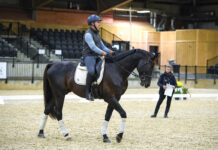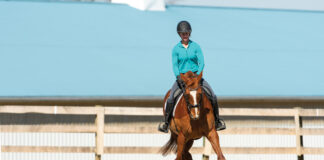 The biggest misconception about Standardbreds is that they don’t canter or gallop; in reality, only a few of them don’t. They have the same ability to perform the canter and gallop gaits as any other horse, but often from their earliest training they have been strongly discouraged from doing so. Most will canter readily after patient and consistent training and can even become fine riding horses. The majority have a tractable nature and, if already trained to the cart, have the basic skills to easily make the transition to carry a rider.
The biggest misconception about Standardbreds is that they don’t canter or gallop; in reality, only a few of them don’t. They have the same ability to perform the canter and gallop gaits as any other horse, but often from their earliest training they have been strongly discouraged from doing so. Most will canter readily after patient and consistent training and can even become fine riding horses. The majority have a tractable nature and, if already trained to the cart, have the basic skills to easily make the transition to carry a rider.
Racetrack Lessons
Off-the-track Standardbreds have many benefits that transfer from the track to the riding stable. They’ve been exposed to crowds, the sights and sounds of heavy equipment, frenetic activity, loud noise and daily handling. These racehorses are shod every six to eight weeks, accustomed to two bits in their mouths, comfortable with harness straps hanging down and jangling around whenever they move, and they respect a whip. And, because they are frequently hauled from track to track, they tend to trailer well and settle into new homes fairly quickly.
On the downside, Standardbreds have been strongly “pulled up” when breaking stride to gallop, which results in their reluctance to make this mistake again. So, they must unlearn an early memorable lesson before they can feel confident and relaxed enough to canter.
Another product of race training is the tendency for Standardbreds to speed up after making a U-turn. (Harness racehorses are exercised, or “jogged,” traveling clockwise on the racetrack, and “turned” counterclockwise to race.) Racing also encourages horses to be hyper-competitive, so sometimes this becomes an issue when riding them in groups.
Even race equipment is counterproductive to teaching the canter to Standardbreds. The overcheck rein that is attached to a bit on one end and snaps to or loops around a hook on the back harness forces the horse’s head up and his nose out, creating a hollow back. To carry a rider comfortably at canter, the horse’s nose needs to come down, and his back should berounded.
Canter Starts on the Ground
Robyn Cuffey, co-author of Retraining the Harness Racehorse and The Essential Guide to Carriage Driving, recommends you start working with your horse from the ground. If he has trouble performing a canter in a round pen or on a longeline, he’ll surely have trouble with it under saddle. Cuffey adds that it’s fairly easy to teach Standardbreds to longe if they haven’t been taught. Currently residing and training at Photo Finish Farm in Buxton, Maine, Cuffey has retrained hundreds of Standardbreds. She is past president of the Standardbred Pleasure Horse Organization (SPHO), an organization devoted to promoting second careers for harness racehorses, and founder of its Maine chapter.
Anne Chunko, administrator of the Standardbred Equine Program (SEP) for the United States Trotting Association (USTA), says that the main concept you want to teach your Standardbred for all gaits is to give to the bit and engage his haunches. “Off-the-track Standardbreds know to stop or slow when pulled up with the bit, but don’t really know anything about giving their heads to pressure. I like to start a horse on the longeline equipped with very loose side reins attached to a surcingle and move him immediately into the trot. The energy from the trot will encourage the horse to round a little when he moves into the bit, not stop or slow as he might at the walk. As he progresses over the weeks, I gradually shorten the reins.” (If you’re unfamiliar with side reins, ask an experienced trainer or friend for guidance.)
Once you think your horse is ready for his first canter on the longeline, you need to prepare yourself for what will probably happen. When you encourage him to go faster, he’ll no doubt speed up at the trot until you’re dizzy, but may eventually canter from his own momentum. If not, a flick of your longe whip may give him added incentive. If he strikes off, praise him lavishly and, after a few strides, bring him back to a trot. Carry out a few more exercises he performs well, and then call it a day.
It is normal if your horse becomes overexcited about these first few canter lessons on the ground because in his mind he’s “breaking stride” and fears correction. Additionally, canter feels more awkward to him than his usual gaits. Above all, stay calm (if you aren’t, fake it) and give a voice command for trot to slow your horse before using more overt pressure. A harsh correction will only reinforce what he fears.
You’ll have more success with these ground lessons (and, when he’s ready, lessons under saddle) if you plan ahead where to ask for canter. For instance, upon approach to an arena corner, your horse will turn his head in the direction he’s going, and his body will be in position to strike off from the outside hind leg. If you give a canter command at the stride before the corner, your horse will likely pick up the proper lead. Preparing your horse to canter on the correct lead by positioning him for success will help him feel more comfortable in upcoming turns and circles.
Regard your Standardbred as untrained for canter the same as you would a young horse learning his first lessons. Use the same methods to teach him as well. Do not canter for extended distances until your horse has built up the muscles for it. He may be trained to trot for a few miles without stopping, but cantering is more physically demanding. You will know when you’ve overdone it when your horse’s strides are really flat, he seems reluctant to pick up the gait when you ask, or just stops doing it once he’s learned how.
Canter Under Saddle
When your horse demonstrates solid ground skills and steadily picks up a canter on the longeline, you are ready to try it under saddle; however, don’t rush to get to this point. All the time and effort you expend on the ground gaining muscle strength, flexibility, obedience and trust will pay off under saddle.
After a horse has spent enough time on the longe to pick up a canter going both directions, Cuffey begins under saddle work with bending and stretching exercises. Standardbreds don’t curve their bodies when they race, so they need to be taught to use their bodies in a different way to strengthen their muscles. Cuffey first teaches a neck-bend by applying a direct, “wiggly” rein on one side of the horse’s neck until he stretches his nose toward the stirrup. (As with all exercises, do this on both the right and left sides.) Then, Robyn practices many other bending and stretching exercises, such as leg yields, walk and trot over ground rails, and “hopping” cavalletti to teach the horse to round his back and elevate his legs.
Your first canter attempts should be in an enclosed arena not only for safety purposes, but because you can use corners to help facilitate the strike-off to canter. If your horse picks up the canter like he was shot out of a cannon, make sure that you do not pull him up or hang on his mouth to slow him. You must stay balanced in the saddle for at least a few strides while praising him like crazy.
“When you decide your horse is ready to attempt a canter, I’ve found it’s best to try it when the horse is somewhat fresh, even ‘revved up’ a bit,” Cuffey says. “The gait requires quite an effort at first, so you need that extra energy.” If the warp speed frazzles you, someone else should be doing the initial canter training.
Cuffey says that through proper training, your horse’s canter departure and gait will improve. “What you’ll notice is that the first stride has lift, and each stride after that gets flatter and flatter,” Cuffey explains. “Practicing canter over time will improve the quality and duration of the strides, but it’s important to note your Standardbred may never have a classic canter. After all, they are bred for efficiency and the breed achieves it at the trot or pace.”
Remember, your horse’s biggest challenge is keeping his balance with your added weight. He may become pretty handy at canter on the longeline, but performing under saddle is quite another thing. At first, you might feel as though his feet are scrambling all over the place and you’re being launched with each stride, but he’ll improve over time with correct training.
Quick Tips for Success
- Plan to canter at the beginning of your riding sessions before you deplete your horse’s physical energy.
- Similarly, avoid teaching your horse to canter on hot, humid days when the weather saps his energy.
- Praise your horse for the tiniest canter effort; you can work on refinement later.
- Gradually add canter to your routine to build your horse’s muscles for it.
- Outside the arena, canter uphill to build muscle and slow the gait.
- Follow a riding buddy in canter to stimulate herd mentality.







Okay for some yes it’s true. Not all standardbreds settle easy because they have moved from place to place just like anyother horse they get confused. I know after 4 1/2 years of ownership of a Standardbred that he still has issues of changing barns or even fields, stalls, food, horse friends it’s all the same. Yes I know he might be an exception but he is not the only one that I have worked with that felt that way. With my gelding if he is not confortable he will pace. Whether we be riding or just in his paddock he will pace. Once he has calmed down or relaxed he will canter or trot. I find when working with Standardbreds to trot or canter undersaddle uphill work is the best. It not only builds the muscle but also they can’t really pace well up hill. It’s also better for horses that can’t or won’t jump. My gelding only started jumping willingly about a couple of weeks ago over logs but he will still not jump accual jumps. It’s just a note that not all standardbred are they same accually they are all quite different and while one fix might do it for that horse but I might not do it for the next. I just did care how the article placed the individual horses into a category. Other than that the tips are great for anyone trying to canter.
Thank you so much for submitting this article!!! I have a Standardbred gelding that I have been trying to work with. Gunner is very afraid of reprimand and doesn’t respond to average horse training. Now, reading this article, it’s all coming together! Thank you so very much! This will help us a lot!
i own a 5 year old standardbred mare, though she never raced, she was trained to drive,she had been backed and lead on leadline but thats it,, and trust me she wasent to happy to have a rider on her. i have had her for 2 years and have done all of her training my self, im only 16. over the years i have really began to understand her, though i no she will never be a top hunter/jumper, i no she is one of the most loyal friends i could ask for. we have grown from a hot uncontrolable standardbred with a novice rider to a leval headed pleasure pony and a experienced rider, we have learned together. haha her walk is good she will bend and move off the leg, trot is ok, she has the tendency to “rack” not pace and not trot but a very smooth trot. she is working well at the canter and picks up the right lead on cue with the lift of the inside hand and the word “canter” the only problem we have is that she has the tendincy to trot on her back legs and canter on the front, its cool if u have never scene a horse do it… i swear it should be a dressage movement lol….can ur warmblood do that hhahahah i love her and she will allways be my first horse and my first horse training experiance.
cool
I’m training my own standardbred to canter and jump. we are entering in our first crossrail-hunter class this april, and i’m training like crazy. this article was helpful 🙂
Thanks so much! This has been really helpful.
I’m currently training a 5yo Standardbred gelding who was an ex trotting racer. so far we’re working on the trot under saddle, but I had no idea how to teach him to canter as this is my first time training a horse.
(By the way: I only added a state because I had to. I’m actually not from America. Just ignore that 🙂 )
good article!
Nice article. We retrained our Standie with the video from the Standardbred Fan Club – they did a fantastic job showing how to retrain with easy and simple steps. Now our Standie trots and canters like a gem!
Great article – I trained a couple of off the track Standardbreds years ago but I didn’t have longing equipment or the knowledge to use it if I had had it. I depended on the bending work first and used it eventually to free up the correct lead leg and then used my seat to push. Even one stride was worth a huge verbal reward.
use trot poles to stop the pacing in the trot
Wow! This I learn’t so much with this information, now i know why standardbreds dont really canter as much as other horses. It’s because they’re unsure whether they can and whether they’re allowed to 🙂 thanks for all the information.
Thank you so much! i have just recently taken on a standardbred as a project. He is an OTT and he trotted and then got taught to pace so he is a little all over the place, he has been broken to saddle but never taught to canter, he also hasnt been worked or riden in a few years. when i lunge him he is really good he trots normally its very rare that he starts to pace. i have done pretty much what this article has said, but his canter looks very flat and a little off. we call it a tranter (trot and canter at the same time) but hopefully with alot more practice he will get it. he is very unbalanced and needs to build up alot more muscle. but thank you very much for this, i will give it all a try.
Great (:
hi, my sister has a standardbred and I am trying to find info on her by her number it’s not going hat well. does anyone know someone I can email to find stuff about her or a website to find stuff on her. her number is PR497.
This is how I found out who my harness raced standarbred is 🙂
http://horseracing.about.com/gi/o.htm?zi=1/XJ&zTi=1&sdn=horseracing&cdn=sports&tm=67&f=10&tt=2&bt=1&bts=1&zu=http%3A//pathway.ustrotting.com/search/index.cfm
Rather than using side reins, I use long reins clipped at the cinch heart, run them up to egg butt snaffle bit, run each in-to-out, then extend back and tie to the saddle or surcingle at rib height. Take up some of the slack but not so much that there’s no relief. Start long and gradually over several days shorten and raise the point at which the rein is tied. I like this better than side reins because the horse can slide his head up and down the rein to find his own relief whereas using side reins with no ‘give’ builds resistance.
The Standardbred Horse Fan Club has an excellent Pacer retraining video for anyone with a Standie that paces. Very easy steps to follow for novice to experienced. You can join the club for free too & there is lots of info on the web site.
Brilliant Article, thank you. Ive just acquired an 11 year old Saddler, he started off as a 5 gaiter,and not a comfortable life after several owners. I took him as a challenge to re school to an eventer. Its an amazing journey understanding his do’s and donts. Hes coming on amazingly. Ive steadied the walk and trot…now the canter begins. I manage a few strides with so much praise…stopping’s a problem, but he listens to my voice. We do lots of ground work, bending, poles,Cavalletti. He pops over anything l face him at. Thank you for understand this amazing horse.